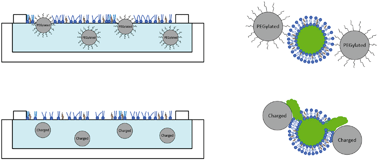当前位置:
X-MOL 学术
›
Environ. Sci.: Nano
›
论文详情
Our official English website, www.x-mol.net, welcomes your
feedback! (Note: you will need to create a separate account there.)
Engineered silica nanoparticles interact differently with lipid monolayers compared to lipid bilayers†
Environmental Science: Nano ( IF 5.8 ) Pub Date : 2017-12-12 00:00:00 , DOI: 10.1039/c7en00685c Ali Asghari Adib 1, 2, 3, 4, 5 , Saeed Nazemidashtarjandi 1, 2, 3, 4 , Alexander Kelly 4, 6, 7, 8 , Adelaide Kruse 2, 3, 4, 9 , Katherine Cimatu 2, 3, 4, 9 , Allan E. David 4, 6, 7, 8 , Amir M. Farnoud 1, 2, 3, 4, 5
Environmental Science: Nano ( IF 5.8 ) Pub Date : 2017-12-12 00:00:00 , DOI: 10.1039/c7en00685c Ali Asghari Adib 1, 2, 3, 4, 5 , Saeed Nazemidashtarjandi 1, 2, 3, 4 , Alexander Kelly 4, 6, 7, 8 , Adelaide Kruse 2, 3, 4, 9 , Katherine Cimatu 2, 3, 4, 9 , Allan E. David 4, 6, 7, 8 , Amir M. Farnoud 1, 2, 3, 4, 5
Affiliation

|
Despite a number of fundamental studies, the interactions of engineered nanoparticles with the cell plasma membrane are still not well understood. Membrane models, such as lipid monolayers and bilayers, have been used to provide a mechanistic understanding of nanoparticle effects on the structure and integrity of the cell membrane. However, the role of the membrane model itself in regulating nanoparticle–lipid interactions has generally been overlooked. In an effort to elucidate how changing the membrane model affects the resulting interactions with nanoparticles, the current study investigates the interaction of silica nanoparticles (104 ± 5 nm) with different surface-functional groups: plain (silanol), amine, and poly(ethylene glycol) (PEG), with various molecular weights of 2k, 5k, and 20k Daltons, with lipid monolayers and bilayers of the same composition. Studies with lipid monolayers demonstrated that PEGylated particles, regardless of the PEG molecular weight, and unlike plain and amine-modified particles, were able to penetrate the monolayer and disrupt the structure of lipids as evidenced by tensiometry and atomic force microscopy. In contrast, when interacting with lipid bilayers in suspension (i.e. vesicles), plain, amine-modified, and PEG 20k-modified particles disrupted vesicle structure, causing significant leakage, while PEG 2k- and 5k-modified particles did not affect the integrity of the vesicles. In summary, while the interactions of silica nanoparticles with membrane models is dependent on particle surface properties, a clear difference is observed in particle interactions with lipid monolayers compared to bilayers.
中文翻译:

与脂质双层相比,工程二氧化硅纳米颗粒与脂质单层的相互作用不同†
尽管进行了许多基础研究,但工程纳米颗粒与细胞质膜的相互作用仍未得到很好的理解。膜模型,例如脂质单层和双层,已用于提供对纳米颗粒对细胞膜结构和完整性的影响的机械理解。然而,膜模型本身在调节纳米颗粒-脂质相互作用中的作用通常被忽略了。为了阐明改变膜模型如何影响与纳米颗粒的相互作用,本研究调查了具有不同表面官能团的二氧化硅纳米颗粒(104±5 nm)的相互作用:普通(硅烷醇),胺和聚乙烯(PEG),分子量分别为2k,5k和20k道尔顿,具有相同组成的脂质单层和双层。对脂质单层的研究表明,聚乙二醇化的颗粒(无论PEG的分子量如何)均不同于普通和胺改性的颗粒,能够穿透单层并破坏脂质的结构,如张力测定法和原子力显微镜所证明的那样。相反,当与悬浮液中的脂质双层相互作用时(例如,囊泡),普通的,胺改性的和PEG 20k修饰的颗粒破坏了囊泡结构,导致明显的渗漏,而PEG 2k和5k修饰的颗粒并未影响囊泡的完整性。总之,尽管二氧化硅纳米颗粒与膜模型的相互作用取决于颗粒表面性质,但与双层相比,与脂质单层的颗粒相互作用观察到明显的差异。
更新日期:2017-12-12
中文翻译:

与脂质双层相比,工程二氧化硅纳米颗粒与脂质单层的相互作用不同†
尽管进行了许多基础研究,但工程纳米颗粒与细胞质膜的相互作用仍未得到很好的理解。膜模型,例如脂质单层和双层,已用于提供对纳米颗粒对细胞膜结构和完整性的影响的机械理解。然而,膜模型本身在调节纳米颗粒-脂质相互作用中的作用通常被忽略了。为了阐明改变膜模型如何影响与纳米颗粒的相互作用,本研究调查了具有不同表面官能团的二氧化硅纳米颗粒(104±5 nm)的相互作用:普通(硅烷醇),胺和聚乙烯(PEG),分子量分别为2k,5k和20k道尔顿,具有相同组成的脂质单层和双层。对脂质单层的研究表明,聚乙二醇化的颗粒(无论PEG的分子量如何)均不同于普通和胺改性的颗粒,能够穿透单层并破坏脂质的结构,如张力测定法和原子力显微镜所证明的那样。相反,当与悬浮液中的脂质双层相互作用时(例如,囊泡),普通的,胺改性的和PEG 20k修饰的颗粒破坏了囊泡结构,导致明显的渗漏,而PEG 2k和5k修饰的颗粒并未影响囊泡的完整性。总之,尽管二氧化硅纳米颗粒与膜模型的相互作用取决于颗粒表面性质,但与双层相比,与脂质单层的颗粒相互作用观察到明显的差异。









































 京公网安备 11010802027423号
京公网安备 11010802027423号